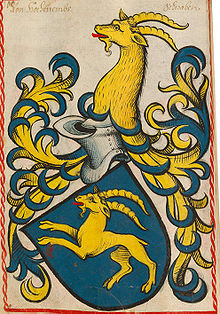Franz Wilhelm II of Hohenems
Franz Wilhelm II of Hohenems (* 1654 - † August 27, 1691 in Peterwardein in today's Serbia ) was a count from the noble family Hohenems-Vaduz . Without him, today's Principality of Liechtenstein would most likely not exist.
Life
Franz Wilhelm II von Hohenems was the youngest son of Franz Wilhelm I von Hohenems and Landgravine Eleonora Katharina von Füstenberg . He had four siblings, including Ferdinand Karl von Hohenems and Jakob Hannibal III. from Hohenems . (A sister and another brother died in childhood). In contrast to his older brothers, who studied at the university in Salzburg , he chose an early military career. Under Emperor Leopold I, he served as an imperial chamberlain, first lieutenant and regiment commander. The Emperor respected the Count of Hohenems very much and on July 1, 1688, gave him the management of the imperial fortress Alt-Ems and the county of Hohenems . In doing so, the emperor passed over the actual beneficiary, his brother Jakob Hannibal III. from Hohenems . The emperor accused his brothers of mismanagement in the Schellenberg rule and in the county of Vaduz . His eldest brother, Ferdinand Karl von Hohenems , in particular, fell out of favor with the emperor. He is said to have enriched himself with the victims of witch trials . In 1681 the execution of the Reich was initiated against him and the Kempten abbot Rupert was commissioned to carry it out. It was his younger brother Jakob Hannibal III. von Hohenems , who reported him to the Kaiser. But his subjects had also made representations to the emperor. On June 22nd, 1684, the count was deposed after he had already lost sovereignty over criminal jurisdiction in 1683 and had been arrested. He was also obliged to return the illegally acquired property to the surviving dependents of the victims.
On April 3, 1691, Franz Wilhelm II von Hohenems married the daughter of Maximilian II von Liechtenstein , Aloisia Josepha von Liechtenstein . The marriage laid the foundation for the family and economic relationships between the House of Liechtenstein and the Counts of Hohenems. Only through this marriage are the later sales of the Schellenberg rule in 1699 and the County of Vaduz in 1712 by Jakob Hannibal III. von Hohenems to explain. Without this marriage there would most likely be no Liechtenstein principality in the area of the Counts of Hohenems .
Franz Wilhelm II of Hohenems died on August 27, 1691 in Peterwardein near Novi Sad in what is now Serbia , a few months after their marriage.
Web links
- Karl Heinz Burmeister: Hohenems, Franz Wilhelm II. Von. In: Historical Lexicon of the Principality of Liechtenstein .
Individual evidence
- ^ Report on the blasphemous life of Count Ferdinand Karl Franz von Hohenems in Vaduz
- ↑ Otto Seger: The last act in the drama of the witch trials in the county of Vaduz and rule Schellenberg . In: Yearbook of the Historical Association for the Principality of Liechtenstein . tape 57 . Vaduz 1957, p. 165 ( eliechtensteinensia.li [PDF; 2.6 MB ; accessed on June 23, 2013]).
| personal data | |
|---|---|
| SURNAME | Hohenems, Franz Wilhelm II. Von |
| BRIEF DESCRIPTION | Count |
| DATE OF BIRTH | 1654 |
| DATE OF DEATH | August 27, 1691 |
| Place of death | Peterwardein |

